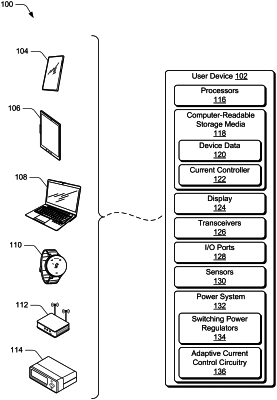| CPC H02M 3/1586 (2021.05) [H02M 1/0009 (2021.05); H02M 3/157 (2013.01)] | 20 Claims |

|
1. A method implemented by a switching power regulator to increase output current in response to an increase of a load on the switching power regulator, the method comprising:
detecting the increase of the load at an output of the switching power regulator;
initiating, in response to the increase of the load, an adaptive current control mode of the switching power regulator in which a clock of the switching power regulator is prevented from affecting application of current to an inductor of the switching power regulator;
implementing a first phase of the adaptive current control mode in which the current is applied, via a first switch device and from an input of the switching power regulator, to the inductor of the switching power regulator until inductor current reaches a predefined level for maximum current;
implementing a second phase of the adaptive current control mode in which the current is enabled to flow, via a second switch device and from a potential lower than the input of the switching power regulator, through the inductor until the inductor current reaches a current control signal that is based on an output voltage of the switching power regulator;
detecting a reduction of the load at the output while the switching power regulator operates in the adaptive current control mode; and
transitioning, in response to the reduction of the load at the output, the switching power regulator to operate in a steady state mode in which the clock of the switching power regulator affects the application of the current to the inductor of the switching power regulator.
|